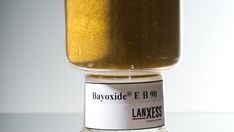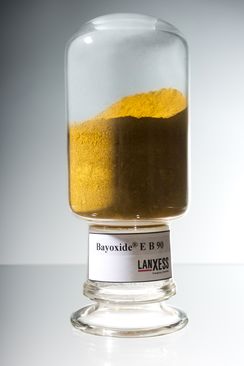News
2012-12-14
Bayoxides from LANXESS for e-mobility
Specialty chemicals group develops tailored iron oxide pigments for lithium-ion batteries
December 14, Leverkusen/Shanghai - Specialty chemicals group LANXESS has developed a range of iron oxides for the production of cathodes for lithium-ion batteries. Thanks primarily to their good morphological properties and high reactivity, the products are ideally suited for use in the e-mobility field. The latest development is the engineered iron oxide Bayoxide E B 90.
The Bayoxide line includes special iron oxides with various particle sizes, crystal shapes and structures as well as purity grades to satisfy individual customer requirements. The products help manufacturers to produce high-performance batteries for electric cars.
Chemical know-how for eco-friendly drive technology
All major automobile makers are working to develop sustainable and economical electric cars. Traffic worldwide is increasing rapidly, and legislation at both national and international level is imposing increasingly stringent limits on automotive CO2 emissions. According to Jörg Hellwig, head of the Inorganic Pigments (IPG) business unit, “Electric cars are an important step toward making mobility, which is growing rapidly all around the world, both sustainable and ecological. However, consumer acceptance is contingent upon reasonable total costs. The batteries, particularly their service life and range, play a key role here. Our Research department is therefore working on tailored products to meet the challenges that eco-friendly yet economical drive technology poses for the industry. As a specialty chemicals group, it is our job to find individual solutions for our customers.”
It is estimated that the global market potential for just the batteries for electromobility applications could reach EUR 20 billion by 2020. One factor for the success of a battery is the cathode technology. It must strike a balance between energy and power density, safety, service life and costs. The LFP cathode (lithium iron phosphate, LiFePO4) has proved effective at balancing all these requirements. Whereas the first generation of LFP cathodes contained solutions made from precipitated LFP or LFP produced from iron oxalate by means of a sinter process, many manufacturers today turn to the carbothermic reaction of iron oxide, lithium compounds and phosphorous compounds.
Long-term partnerships as the key to successful innovation
“The key to success is not just the high quality of our products. Even more important to our customers are our development capabilities and our willingness to enter into long-term partnerships,” says Hellwig. “As one of the world's leading manufacturers of iron oxide pigments, we have sufficient capacity to reliably service the rising demand for iron oxides for the production of cathode materials for e-mobility applications.”
“The continuous investment in our research and development has already resulted in several innovative products,” says Dr. Hendrik Kathrein, head of the Global Competence Center Specialties at IPG. “Ultimately, however, successful product development, particularly for such complex areas of application, requires close and trusting collaboration with our customers. We are working on custom products for battery manufacturers, for example, because these products must be optimally adapted to the customer's requirements profile and there is also often a desire for exclusivity.”
For once color is unimportant
The pigments in the Bayoxide range have been developed for diverse markets, industries and requirements. The broad range includes products for the manufacture of airbags, brake pads and catalytic converters, pigments for toner used in copiers and laser printers, and adsorbents used for drinking water and wastewater purification, for example. Another very innovative application is the use of Bayoxides for the desulfurization of biogas. The range is broken down into Bayoxide E pigments, which are produced on the basis of iron oxide pigments, and the Bayoxide C pigments, which are manufactured on the basis of chrome oxide. Like the pigments for coloring building materials or plastics, the Bayoxides also have a specific hue (red, yellow, green or black), but this plays only a minor role compared with the technical chemico-physical product properties.
IPG is one of the world's largest manufacturers of inorganic iron oxide and chrome oxide pigments with production sites in Germany, Brazil and China, as well as additional mixing and milling plants in Australia, China, Spain, the United Kingdom and the United States. The business unit is part of LANXESS’ Performance Chemicals segment, which recorded sales of EUR 2.13 billion in fiscal 2011.
LANXESS is a leading specialty chemicals company with sales of EUR 8.8 billion in 2011 and currently around 17,100 employees in 31 countries. The company is at present represented at 49 production sites worldwide. The core business of LANXESS is the development, manufacturing and marketing of plastics, rubber, intermediates and specialty chemicals. LANXESS is a member of the leading sustainable indices Dow Jones Sustainability Index (DJSI) World and FTSE4Good.
Forward-Looking Statements
This news release may contain forward-looking statements based on current assumptions and forecasts made by LANXESS AG management. Various known and unknown risks, uncertainties and other factors could lead to material differences between the actual future results, financial situation, development or performance of the company and the estimates given here. The company assumes no liability whatsoever to update these forward-looking statements or to confirm them to future events or developments.
Information for editors:
All LANXESS news releases and accompanying photo, video and audio material can be found at http://www.lanxess.cn or http://www.weibo.com/lanxess.
Information on chemical products from LANXESS can also be found in our Web Magazine at http://webmagazine.lanxess.cn.






